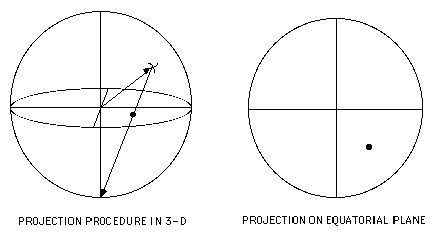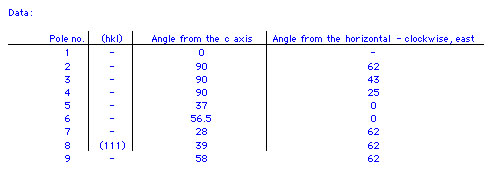
STEREOGRAPHIC PROJECTIONS LABORATORY
The Stereographic Projection.
Unfortunately, much of our intellectual world is, at the present time, flat. We get much of our information from the pages of a book, the TV or computer screen, paper, etc. Three-dimensional objects in these media are projected onto two-dimensions, and it is left to our minds to add depth to the projected images. We must also make projections in crystallography, but the usual type of projection, the stereographic projection, is constructed in a manner which is somewhat different from that to which you are probably accustomed. Our first use of stereographic projections will be to graphically represent symmetry operations and their results.
A stereographic projection is a means of showing a three-dimensional configuration in two-dimensions, and is drawn as described below.
Procedure
The purpose of the stereographic projection is to describe a 3-D object, array, etc., in two dimensions such that quantitative measurements of solid angles can be made from the projection. Plane normals (poles) are usually plotted in crystallography. The object to be described is placed at the center of a sphere in the desired orientation. The poles are extended until they hit the sphere. Then a line is drawn from each point where a pole hits the sphere to the south (or north) pole. Where these lines pass through the equatorial plane, the projected points are marked.
Refer to figure 1.
Draw a sphere and locate the north and south poles, and the equator. Place the object or configuration at the center of the sphere. For crystals, the symmetry elements and the poles of the crystal planes (the poles are the normals to the crystal planes; see the discussion on crystal planes below) are usually projected. The pole is extended from the center of the sphere to its surface. The resulting point on the surface, if in the northern hemisphere, is connected to the south pole with a line; where this line intersects the equatorial plane, a point is marked thus: ____ (If the point is in the southern hemisphere, the point is connected to the north pole and the projected point is shown as: 0.)
Plane normals
Plane normals are useful in stereographic projections. Note, however, that the plane normals are not the same as crystallographic directions. These are only equivalent for the cubic crystal system. Crystallographic directions [uvw] are rational directions, i. e., directions along lines which must pass through at least two lattice points.
Zones
Any two planes intersect along a line which is called a zone axis. A number of planes may have the same zone axis, which means that each plane is parallel to the same line. The zone axis [uvw] is calculated as ui + vj + wk from:

A plane (hkl) belongs to the zone [uvw] if hu + kv + lw = 0. If (h1 k1 l1) and (h2 k2 l2 ) are in the same zone then (h1+h2 k1+k2 l1+l2 ) is also in the same zone.

Figure 1. Procedure for drawing a stereographic projection. Only the projected point (right) for one pole (left) is shown.
The lab exercise
The purpose of this exercise is to become familiar with various aspects of stereographic projections. You are to construct a projection, on a piece of translucent paper, from data given below using an angle measuring device called a Wulff net. The use of the Wulff net will be explained to you and demonstrated. You will also need to use the cross product rule for zones and the zone law.
Specifically, do the following:
1. Use the angular data below to plot the poles for an orthorhombic crystal, projecting down the c axis.
2. Draw all the symmetry related poles.
3. Proceed to index all the poles using the cross product rule for zones and the zone law. Do the lower left quadrant of the projection first. Judiciously select two or three pairs of points and draw great circles through each pair. If correctly done, the circles will intersect at some point which is probably not at the position of one of the poles which you have plotted.
4. Calculate the zone axis for each pair and then index the fictitious poles through the use of the zone law. Remember that all (nh nk nl) (n=integer) poles are located at the same position. Through iteration of this procedure, all of the poles can be indexed.
5. Calculate the ratios of the lengths of the crystallographic axes.
